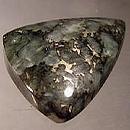|
Click on a letter above to view the list of gems. |
|
|
|
|
|
|
|
|
Platinum
(Native) |
|
| | |
| Discovered in 1748; IMA status: Valid (pre-IMA; Grandfathered) | ||
|
| ||
|
Chemistry |
| ||||||||||
|
| |||||||||||
|
Pt | |||||||||||
|
|
Platinum (Elemental Platinum) | ||||||||||
|
Molecular Weight: |
195.08 gm | ||||||||||
|
Composition: |
| ||||||||||
|
|
|
Classification |
|
|
| |
|
Elements | |
|
1/A.14-70 | |
|
|
1 : ELEMENTS (Metals and intermetallic alloys; metalloids and
nonmetals; carbides, silicides, nitrides, phosphides) |
|
Related to: |
Platinum Group elements |
|
Varieties: |
Avaite, Ferroan Platinum, Palladian Platinum, Rhodic Platinum |
|
Synonyms: |
Native Platinum, Polyplatinum |
|
|
|
|
Crystal Data |
|
|
|
|
|
Cubic crystals, typically distorted, to 1.5 cm; commonly as grains or scales, rarely as nuggets or lumps up to 30 kg. |
|
|
On {111}, as interpenetrant contact twins. |
|
|
|
|
|
Physical Properties |
|
|
|
|
|
None |
|
|
Hackly |
|
|
Malleable and Ductile |
|
|
4.0 - 4.5 |
|
|
14.0 - 19.0 (g/cm3) |
|
|
None |
|
|
Not Radioactive |
|
|
Other: |
Nonmagnetic to distinctly magnetic when rich in iron. |
|
|
|
|
Optical Properties |
|
|
|
|
|
Whitish Steel Gray, Steel Gray, Dark Gray |
|
|
Opaque |
|
|
Metallic |
|
|
R: (400) 60.5, (420) 62.3, (440) 63.8, (460) 65.1, (480) 66.3, (500) 67.5, (520) 68.6, (540) 69.5, (560) 70.2, (580) 70.7, (600) 71.2, (620) 71.6, (640) 71.8, (660) 72.1, (680) 72.4, (700) 72.8 |
|
|
0.00 (Opaque) |
|
|
|
|
|
Occurances |
|
|
|
|
|
Geological Setting: |
Chiefly in placer deposits, or in mafic and ultramafic igneous rocks; rarely in hydrothermal quartz veins or contact metamorphic deposits. |
|
Common Associations: |
Chalcopyrite, Chromite, Magnetite, Pt–Fe alloys |
|
Common Impurities: |
Fe, Ir, Os, Rh, Pd, Au, Cu |
|
Type Locality: |
Pinto River, San Juan River Basin, Papayan, Cauca, Chocó Department, Colombia |
|
Year Discovered: |
1748 |
|
View mineral photos: | |
|
|
|
|
More Information |
|
|
|
|
|
| |
|
|
|
|
Platinum is more rare than gold and is typically more expensive by weight than Gold. Chemically, Platinum is very non-reactive and can facilitate many chemical reactions without being altered in the process. It is used in many anti-pollution devices, especially catalytic converters. For this reason, it has been nick named the "Environmental Metal". Platinum
is found in many deposits world-wide. In the Pinto River, near Papayan,
in the Department of Chocó, Cauca, Colombia (the Type
Locality). In
the USA, from Platinum Creek, Goodnews Bay, Alaska;
in California, in a number of placers, as in Trinity
County; and at Oroville, Butte County In Oregon, at Cape Blanco,
Port Orford, Curry County In Canada, at Rivière-du-Loup
and Rivière des Plantes, Beauce County, Quebec; in British
Columbia, in the Kamloops district, on the Fraser and
Tranquille Rivers, and in the Similkameen district,
on Granite, Cedar, and Olivine Creeks, tributaries to
the Tulameen River; in Alberta, near Edmonton. In Russia,
in the Ural Mountains, in a large district surrounding
Nizhni Tagil; good crystals from the Konder massif,
Aldan Shield, Sakha. In South Africa, at a number of
deposits along the Merensky Reef of the Bushveld complex,
Transvaal. |
|
|
We
have not photographed our Platinum gems. Please
check back soon. |
